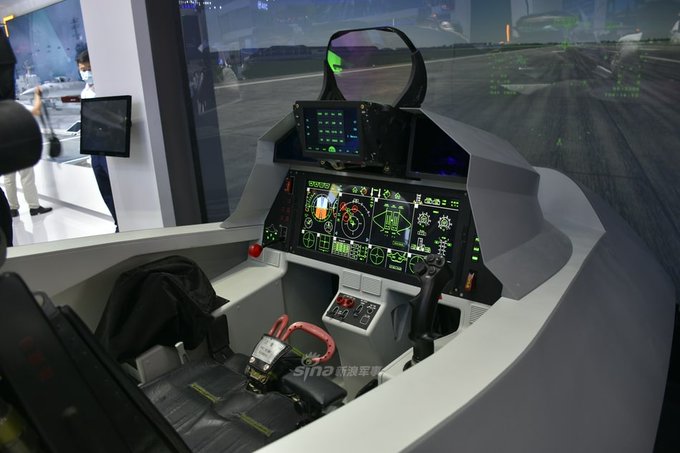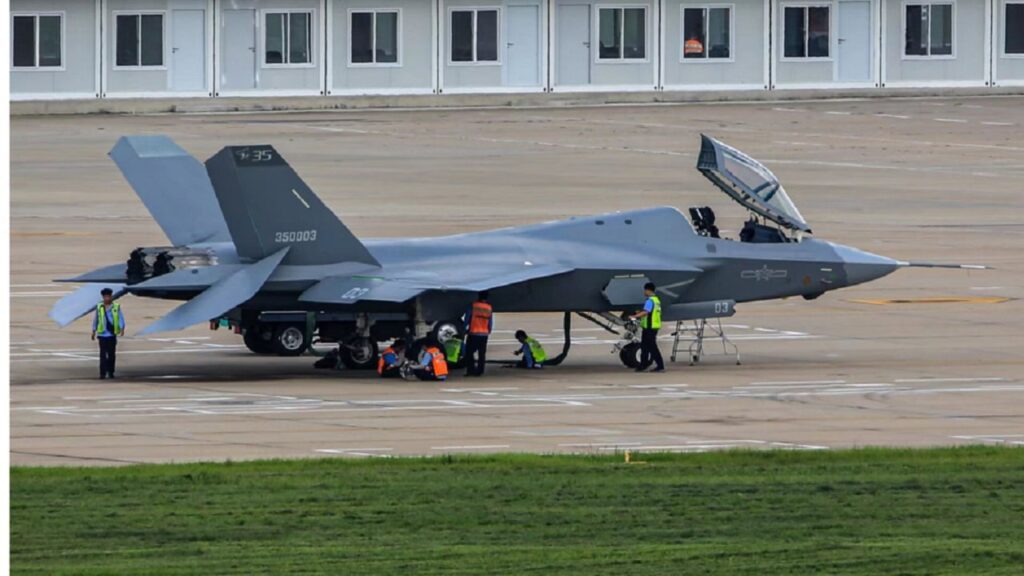(By Khalid Masood)
At the 2024 Zhuhai Air Show, China officially unveiled the Shenyang J-35A, a fifth-generation stealth fighter that marks a significant evolution in the PLA Air Force’s (PLAAF) capabilities. Derived from the FC-31 prototype, the J-35A joins the J-20 in operational service, positioning China as the only country besides the United States to field two stealth fighter platforms. Designed for air superiority, multi-role adaptability, and carrier-based operations, the J-35A is also intended for export, with Pakistan among the first potential operators.
However, its striking resemblance to the U.S. F-35 Lightning II has reignited longstanding allegations of cyber-espionage and technology replication. In this analysis, we break down the J-35A’s design and capabilities, compare it with its Western and Russian peers, and assess its strategic implications across the Indo-Pacific.
J-35A: Capabilities and Design Profile
Stealth & Airframe Design
- Optimized for low radar cross-section (~0.01–0.1 m²), the J-35A features Diverter-less Supersonic Inlets (DSI), serrated nozzles, internal weapons bays, and radar-absorbent materials (RAM).
- However, its stealth shaping and material science remain less refined than U.S. standards.
Propulsion & Performance
- Equipped with twin WS-13E or WS-21 engines (total thrust: ~215.6 kN), the J-35A achieves Mach 1.8–2.0, potentially with limited super-cruise.
- Estimated combat radius: ~750 miles, constrained by China’s aerial refueling capability.
Avionics & Situational Awareness
- Features include KLJ-7A AESA radar, 360° IRST, and potential helmet-mounted display systems.
- Designed to operate in a networked environment alongside drones and J-20s.
Variants & Export Plans
- J-35A (land-based) for PLAAF
- J-35 (carrier-based) for PLAN (Fujian-class carrier)
- J-35E (export version); Pakistan reportedly ordering 40 units
Cost Efficiency
- At approximately $70 million per unit, it offers a low-cost alternative to Western stealth platforms, enhancing its export viability.
Concerns
Reliance on Russian engine designs (despite progress on WS-19) and unproven combat record remain major caveats.

Comparison Table: J-35A vs Global Rivals
| Feature | J-35A | F-35 Lightning II | Su-35S | Rafale |
| Origin | China | USA | Russia | France |
| Generation | 5th Gen | 5th Gen | 4.5 Gen | 4.5 Gen |
| Stealth (RCS) | ~0.01–0.1 m² | ~0.001 m² | ~1–3 m² | ~0.1–0.5 m² |
| Engines | WS-13E / WS-21 (twin, ~215.6 kN) | F135 (~191 kN, single-engine) | AL-41F1S (~284.4 kN) | M88 (~150 kN) |
| Speed (Mach) | 1.8–2.0 (with potential supercruise) | 1.6 (no supercruise) | 2.25 (with supercruise) | 1.8 (no supercruise) |
| Combat Radius | ~1,200 km (750 miles) | ~1,390 km (865 miles) | ~3,600 km | ~1,850 km |
| Avionics | KLJ-7A AESA, IRST, networked | AN/APG-81 AESA, DAS, EOTS, HMDS | Irbis-E PESA, Khibiny EW | RBE2 AESA, SPECTRA EW |
| Internal Weapons | 4–6 PL-15 (ventral bay) | 4–6 AMRAAMs/GBUs (internal) | External-only | External-only |
| Operational Role | Multi-role, networked, point-defense | Multi-role, networked “quarterback” | Air superiority, dogfighting | Multi-role, strike, deterrence |
| Combat Record | None (prototype stage) | Proven (Syria, Iraq) | Proven (Syria, Ukraine) | Proven (Libya, Mali) |
| Export Cost | ~$70 million | ~$110 million | ~$85 million | ~$245 million |
| Export Status | Pakistan, Egypt (interest) | 15+ allied countries | China | India, UAE, Greece, Indonesia |

Strategic Implications
- Regional Power Projection
The J-35A is integral to China’s anti-access/area denial (A2/AD) strategy in the South China Sea and Taiwan Strait. Its integration into carrier strike groups extends China’s power projection beyond the first island chain. - Pakistan’s Acquisition
Pakistan’s order of 40 J-35Es reflects strategic counterbalance against India’s Rafale fleet and AMCA delays. The addition of a fifth-generation fighter would significantly upgrade Pakistan’s deterrent posture. - India’s “Stealth Gap”
With the AMCA program delayed until at least 2034, India finds itself lagging in fifth-generation capabilities. The J-35A’s deployment, particularly in the region, amplifies strategic asymmetry. - Export Disruption
The J-35A undercuts both the Rafale and F-35 in cost, making it an attractive option for non-aligned and Global South air forces. Its success could reshape the global defense market away from Western monopolies.

Conclusion
The J-35A is not merely an imitation—it’s a strategic statement. It blends affordability, stealth, and multi-role capability into a package designed to challenge Western air dominance, especially in contested regions like the Indo-Pacific. While it still lags behind the F-35 in sensor fusion and combat-proven systems, it exceeds the Su-35 in stealth and cost-effectiveness, and rivals the Rafale in strike versatility while drastically undercutting its price.
China’s decision to field the J-35A alongside the J-20 signals an ambitious shift from regional to global airpower aspirations. Whether it proves to be a true peer or just a shadow of the F-35 remains to be tested—but one thing is certain: it can no longer be dismissed.







